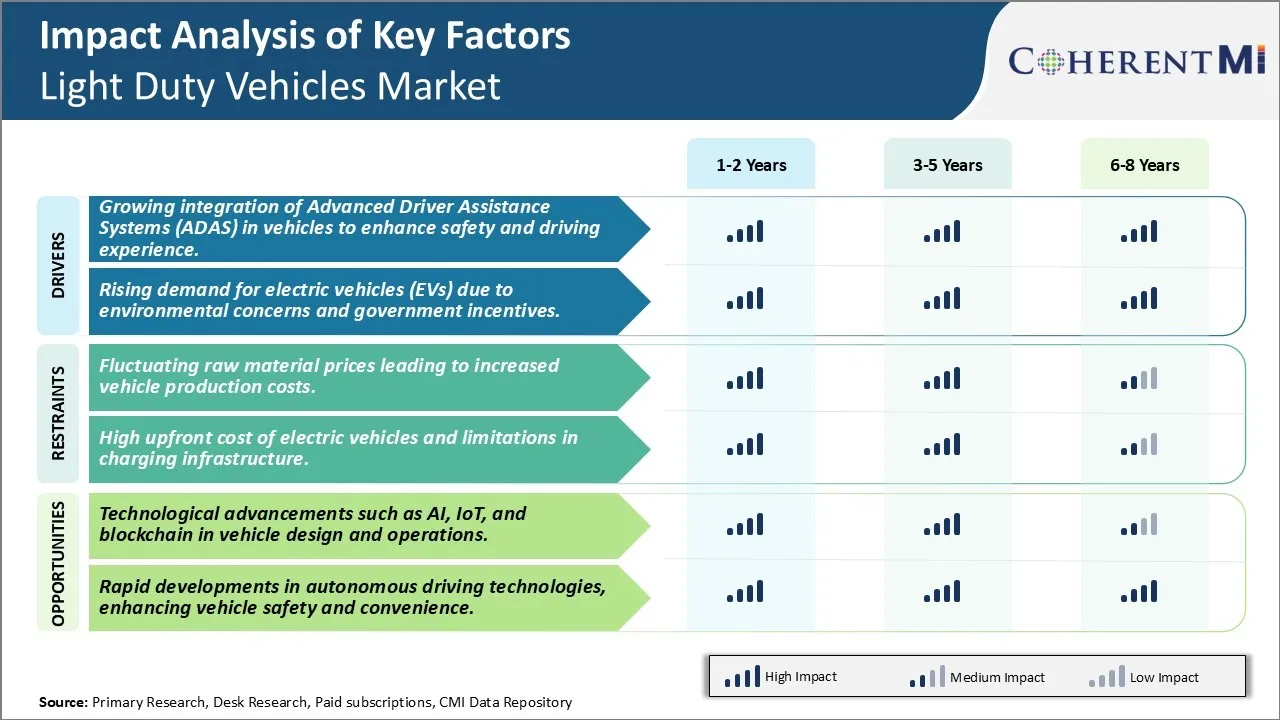Light Duty Vehicles Market Trends
Market Driver - Growing Integration of Advanced Driver Assistance Systems (ADAS) in Vehicles to Enhance Safety and Driving Experience
Automakers are increasingly integrating advanced driver assistance systems in light duty vehicles to enhance safety and provide comfort to drivers. ADAS technologies use cameras, radars and other sensors to automate, adapt and enhance vehicle systems for various functions like adaptive cruise control, lane keep assist, automatic emergency braking, blind spot monitoring and parking assist among others. As these systems take over certain vehicle control tasks from the driver to either assist or replace driver actions, it alleviates driver stress, reduces chances of accidents and improves the overall driving and ownership experience.
Many drivers find advanced features like adaptive cruise control extremely useful on highways and open roads as it automatically maintains a safe distance from vehicles ahead without constantly needing to brake or accelerate. This allows drivers to rest their foot and remain focused on the road ahead. Technologies like lane departure warning and lane keep assist that sense when a vehicle is straying from its lane are also gaining popularity. Such features alert inattentive drivers and guide the vehicle back on track, reducing the likelihood of accidents from distracted or drowsy driving. Automated emergency braking is another crucial system that most vehicles will be equipped with going forward. It uses sensors and cameras to detect if the driver fails to see a slower vehicle or stationary object ahead and applies brakes automatically to prevent or mitigate the impact of a collision. This can potentially save thousands of lives lost annually to accidents worldwide.
Market Driver - Rising Demand for Electric Vehicles (EVs) Due to Environmental Concerns and Government Incentives
There is significant rise in consumer awareness and preference for electric vehicles due to growing environmental concerns about pollution and climate change from traditionally fueled vehicles. While EVs had a modest presence earlier due to higher costs and range limitations, improved technology is making them more desirable and viable choice for mainstream buyers. EVs produce zero direct tailpipe emissions, therefore helping to reduce air pollution in cities and cutting down greenhouse gas emissions that contribute to global warming. Many drivers are attracted to the eco-friendly nature of EVs and wish to switch just for the environmental benefits alone. Aside from factors like rising fuel prices, this green sentiment is a major driver accelerating EV adoption rates across markets.
Several governments are also aggressively promoting EVs through purchase incentives and policies to meet climate goals. Financial incentives like tax credits and subsidies are making EVs very competitively priced compared to internal combustion engine vehicles. Some nations are planning to move towards electric mobility completely within the next decade or two by proposing deadline to phase out petrol and diesel vehicles. Several cities and states are offering special parking and driving privileges for EVs to appeal more buyers. Additionally, many local authorities have enacted emission regulations aimed at traditional vehicles in phases, which will eventually make ICE vehicles costlier to own and drive. All these governmental policies and initiatives are fueling faster consumer receptiveness towards electric mobility.

Market Challenge - Fluctuating Raw Material Prices Leading to Increased Vehicle Production Costs
Raw material prices strongly impact vehicle production costs as these materials constitute a major portion of total cost for automakers. Prices of metals like steel and aluminum that are primarily used in vehicle manufacturing have witnessed high volatility in recent years. Steel prices especially rose significantly between 2017 and 2018 due to reduced supply from China and higher demand. Aluminum prices too saw a sharp rise in the recent past and continue to fluctuate often. Sudden price surges strain automaker's profitability as raw material costs become difficult to account for accurately during vehicle pricing. It also disrupts Their supply chain dynamics and production planning. To maintain margins, additional costs often need to be passed on to customers making vehicles expensive. This price volatility poses a major challenge to automakers' cost control abilities and financial planning for new vehicle programs.
Market Opportunity- Technological Advancements Such as AI, IoT, and Blockchain in Vehicle Design and Operations
Emerging technologies are driving extensive innovation in automotive industry. Applications of AI, IoT and blockchain bring in both opportunities to enhance customer experience and challenges to integrate them seamlessly. AI and IoT based applications can make vehicle operations more efficient, convenient and safe. Advanced driver assistance systems, predictive maintenance. Usage-based insurance are some such areas. Blockchain's decentralized networks support building digital trust and transparency in processes like vehicle records verification, part supplies traceability benefitting OEMs, dealerships as well as consumers. These latest technologies also enable customized automated driving experiences. However, their complexities and developing nature demand significant investments and cross-industry collaborations for realization of full benefits. If standards are set and technologies integrated properly, they can transform future vehicles and mobility solutions.